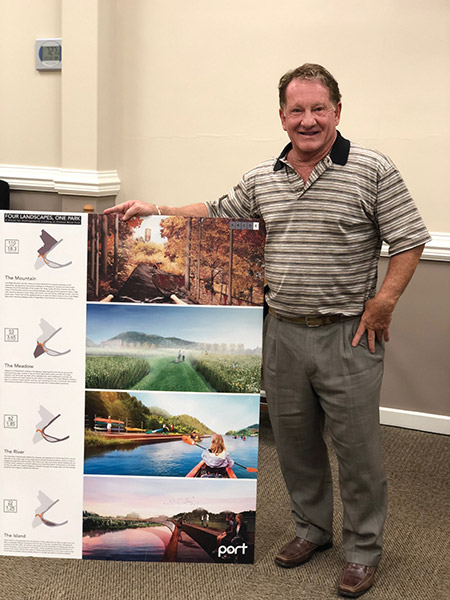Hollingsworth Foundation lays out park plans to Council

Joe Hollingsworth stands with a sign he used during Monday night’s presentation to the city about a potential new 400-plus acre park in South Clinton. He wants the park to be “aspirational” and pull from the city’s strengths. (photo:Crystal Huskey )
The park would be up to 450-acres, and would include land owned by the TVA.
“When the Clinton Vision stepped forward, we decided to move forward with the park,” he said. “It would be totally funded outside of government funds. We’re just presenting this to you in hopes we can get untiring support.”
The vision for the park is beautiful and creative. In fact, Hollingsworth said a Disney Imagineer would be involved in creating the experience of the park. He said he wanted the whole thing to be “aspirational.”
It would be in South Clinton and feature four landscapes: the river, mountain, islands and meadow.
But the meadow portion of the park has some city officials concerned. It sits on 42 acres that were once used as a fly ash, also known as coal ash, disposal site by the TVA for years. City mayor Scott Burton and members of the city council questioned the safety of the site during last month’s council meeting. They requested input from the Tennessee Department of Energy and Conservation, and representatives from TDEC came to this month’s meeting.
“Fly ash is in everything,” Hollingsworth said. “It’s just how you use it. I’ve monitored this for a long time.”
Hollingsworth owned the land that the TVA used to dump over a million cubic yards of the ash; it was brought in and used as fill to level off the site. Back then, it met all EPA requirements and done by the book.
And it’s true that fly ash is frequently reused in everything from concrete, grout, kitchen countertops, window frames, to bowling balls and bricks, and is also used for soil stabilization and fill.
But within the past decade, environmental concerns have made headlines. On Dec. 22, 2008, an ash dike ruptured at the Kingston Fossil Plant, releasing 1.1 gallons of coal ash slurry.
The ash contains contaminants like mercury, cadmium and arsenic, according to the EPA, which can contaminate waterways, ground water, drinking water and the air. The ash stored in South Clinton isn’t slurry; it’s dry.
Also in 2008, Constellation Energy was forced to pay a $54 million penalty after performing a “restoration project” of filling an abandoned gravel quarry with fly ash, which contaminated area waterwells with heavy metals, according to a 2008 Baltimore Business Journal article.
During the meeting, city councilmember Jim McBride asked TDEC representatives if they were the right body to go to for questions regarding fly ash safety. They said they were, and that TDEC does support bringing the property back to use. They recommended that council go through a brownfield study, which would protect all parties involved against liability.
The permit to store fly ash was issued in 1994, according to TDEC representatives, and the fill went on until 2004. In 2008, it was closed and capped off, which involved two feet of clay. It also has a clay liner. The site was monitored by TDEC until 2012 or 2013.
“I know with the recent news article with Kingston, they talked about air contamination,” said McBride. “Is that something that needs to be of concern or checked on?”
McBride clarified that he is very excited about this potential park and thinks it’s a “super duper” idea, but that he feels the need to be cautious. He asked Hollingsworth if he intended to go through TDEC’s brownfield program.
“We need to make sure that this small part is safe,” McBride said.
“This was done with a lot of incredible foresight. I have watched this pretty carefully. Nothing’s been disturbed there,” Hollingsworth responded. “Out of the drainage pipe that runs under this, we got the test results from today from the water coming out of that pipe and you can drink it. We have no loss of fly ash, there’s no contaminants here, the contaminants are encased.”
The brownfield program, though, would take too long to go through, according to Hollingsworth, and would only release them from liability if there were to be problems. In a follow up call, Mike Wallace, executive director of the Hollingsworth Foundation, told The Courier News that they are still reviewing the brownfield program requirements before making a decision.
“We know what we have to do liability-wise,” he said. “We have a safety plan drafted in place if someone accidently touches it. We’re going to protect ourselves obviously, and the city and the citizens, but the brownfield only protects liability, it doesn’t guarantee a success. We’d like to take it a level above that if we could, ourselves, but we’re not sure a brownfield is the best way to go. We’ve got great incentive to do that right. So we’d like to take it a level above that ourselves.”

